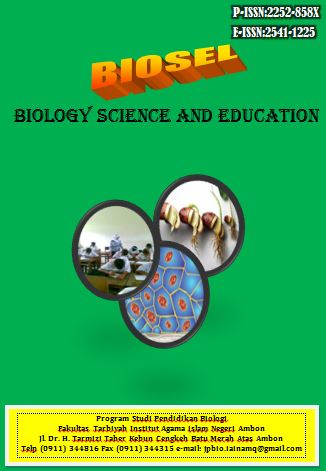Observation and Analysis of Stomata Characteristics of Rhoeo discolor Leaves Based on Different Times
DOI:
https://doi.org/10.33477/bs.v14i1.8870Abstract
Stomata are important structures in leaves that function in gas exchange and regulating air loss. The research focuses on the characteristics of Rhoeo discolor leaf stomata which are influenced by sampling time, taking into account environmental factors such as light, temperature and humidity. The aim of this research is to provide insight into the physiological adaptation of tropical plants to environmental change. The method used includes observing stomata in the morning (08.00 WIB) and afternoon (16.00 WIB) using a light microscope, where five samples are taken at each observation time to analyze the number of open and closed stomata. The results showed that the average number of open stomata was higher in the morning (24 stomata) than in the afternoon (17 stomata). This results in high stomata density in the morning, while in the afternoon it is low. Not only that, for the characteristics of stomata based on the location of the stomata on the leaf surface, the Rhoeo discolor stomata type is the Amphistomatic type. Meanwhile, based on its shape, the type of stomata that these stomata have is the tetracytic stomata type. In conclusion, sampling time has a significant effect on the characteristics of stomata in Rhoeo discolor, with more stomata opening in the morning associated with higher light intensity, supporting the efficiency of photosynthesis and air use in plants.
Keywords: Stomata, Rhoeo discolor, Photosynthesis, Environmental Conditions
Downloads
Published
Issue
Section
License

This work is licensed under a Creative Commons Attribution-NonCommercial 4.0 International License.
Authors who publish with this journal agree to the following terms: Authors retain copyright and grant the journal right of first publication with the work simultaneously licensed under a Creative Commons Attribution License that allows others to share the work with an acknowledgement of the work's authorship and initial publication in this journal. Authors are able to enter into separate, additional contractual arrangements for the non-exclusive distribution of the journal's published version of the work (e.g., post it to an institutional repository or publish it in a book), with an acknowledgement of its initial publication in this journal. Authors are permitted and encouraged to post their work online (e.g., in institutional repositories or on their website) prior to and during the submission process, as it can lead to productive exchanges, as well as earlier and greater citation of published work.













